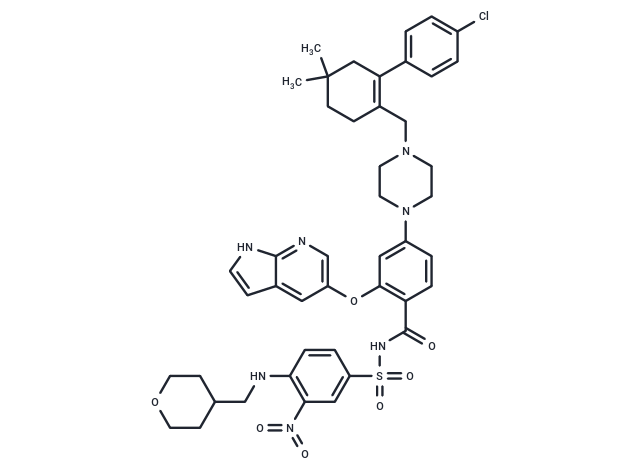 您的购物车当前为空
您的购物车当前为空

crystal structure of BCL-2 with venetoclax
别名 维奈妥拉, GDC-0199, ABT-199, ABT199, ABT 199
Venetoclax (ABT-199) 是一种 Bcl-2 抑制剂 (Ki<0.01 nM),具有高效性、选择性和口服活性。Venetoclax 与 Bcl-xL 和 Bcl-W 的亲和力降低了 3 个数量级(Kis=48/245 nM)。Venetoclax 可以诱导自噬和凋亡。

Venetoclax (ABT-199) 是一种 Bcl-2 抑制剂 (Ki<0.01 nM),具有高效性、选择性和口服活性。Venetoclax 与 Bcl-xL 和 Bcl-W 的亲和力降低了 3 个数量级(Kis=48/245 nM)。Venetoclax 可以诱导自噬和凋亡。
| 规格 | 价格 | 库存 | 数量 |
|---|---|---|---|
| 5 mg | ¥ 495 | 现货 | |
| 10 mg | ¥ 695 | 现货 | |
| 50 mg | ¥ 895 | 现货 | |
| 100 mg | ¥ 1,160 | 现货 | |
| 500 mg | ¥ 2,995 | 现货 | |
| 1 g | ¥ 4,847 | 现货 | |
| 1 mL x 10 mM (in DMSO) | ¥ 663 | 现货 |
| 产品描述 | Venetoclax (ABT-199) is a Bcl-2 inhibitor (Ki<0.01 nM) with potent, selective, and orally active properties. Venetoclax has a 3-order-of-magnitude lower affinity for Bcl-xL and Bcl-W (Kis=48/245 nM). Venetoclax induces autophagy and apoptosis. |
| 靶点活性 | Bcl-2:<0.01 nM (Ki, cell free), BCL-XL:48 nM (Ki, cell free), Bcl-W:245 nM (Ki) |
| 体外活性 | 方法:11 种人 T 细胞急性淋巴细胞白血病细胞 T-ALL 用 Venetoclax (0-12 μM) 处理 48 h,使用 Celltiter-Glo Luminescent Cell Viability Assay 检测细胞活力。 |
| 体内活性 | 方法:为检测体内抗肿瘤活性,将 Venetoclax (100 mg/kg in 60% PG+30% PEG 400+10% ethanol) 口服给药给携带人弥漫大B细胞淋巴瘤 Toledo 的 C.B-17 SCID-beige 小鼠,每天一次,持续二十一天。 |
| 激酶实验 | The equilibrium binding experiments of fluorescent peptides to Bcl-xL protein were performed in an Analyst 96-well plate reader under the following conditions: each individual well in a 96-well assay plate contained 5 μl DMSO, 15 nM fluorescent peptide, and increasing concentrations (from 0 to 2.24 μM) of Bcl-xL protein in assay buffer in a final volume of 125 μl. The plate was mixed on a shaker for 1 min and incubated at room temperature for an additional 15 min. The polarization in millipolarization units (mP) was measured at room temperature with an excitation wavelength at 485 nm and an emission wavelength at 530 nm. For assay stability testing, a plate containing a binding experiment was measured at different times over a 24-h period. Between each reading, the plate was covered with parafilm to prevent any solution evaporation. To determine the effect of DMSO on the assay, binding experiments were performed under conditions similar to those described above except that the amount of DMSO was varied from 0 to 4 to 8%. All experimental data were analyzed using Prism 3.0 software and Kd values were generated by fitting the experimental data using a sigmoidal dose-response nonlinear regression model [1]. |
| 细胞实验 | RS4;11 cells were seeded at 50,000 per well in 96-well plates and treated with compounds diluted in half-log steps starting at 1 μM and ending at 0.00005 μM. All other leukemia and lymphoma cell lines were seeded at 15,000–20,000 cells per well in the appropriate medium and incubated with ABT-199 or navitoclax for 48 h. Effects on proliferation were determined using Cell TiterGlo reagent. EC50 values were determined by nonlinear regression analysis of the concentration-response data. Mouse FL5.12–BCL-2 and FL5.12–BCL-XL cells were propagated and assessed as described previously. Bak?/? Bax?/? double knockout mouse embryonic fibroblasts were seeded into 96-well microtiter plates at 5,000 cells per well in DMEM supplemented with 10% FBS. ABT-199 in the same culture medium was added in half-log dilutions starting at 5 μM. The cells were then incubated at 37 °C (5% CO2) for 48 h, and the effects on proliferation were determined using Cell TiterGlo reagent according to the manufacturer's instructions [1]. |
| 动物实验 | Female C.B-17 SCID mice (DoHH2 and Granta-519 xenografts) and female C.B-17 SCID-beige mice (RS4;11 and Toledo xenografts) were inoculated with 1 × 10^6 (DoHH2) or 5 × 10^6 (Granta-519, Toledo and RS4;11) cells subcutaneously in the right flank. The inoculation volume (0.2 ml) comprised a 50:50 mixture of cells in growth media and Matrigel. Electronic calipers were used to measure the length and width of each tumor 2–3 times per week. Tumor volume was estimated by applying the following equation: volume = length × width2/2. When tumors reached approximately 220 mm3, mice were size matched (day 0) into treatment and control groups. All xenograft trials were conducted using ten mice per group, and all mice were ear tagged and monitored individually throughout the studies. ABT-199 was formulated for oral dosing in 60% phosal 50 propylene glycol (PG), 30% polyethylene glycol (PEG) 400 and 10% ethanol, and bendamustine and rituximab were formulated in accordance with the manufacturer's instructions. ABT-199 was delivered approximately 2 h before bendamustine or bendamustine plus rituximab. TGImax was calculated as the greatest treatment response using the following equation: TGImax = (1 ? mean tumor volume of the treated group/mean tumor volume of the vehicle control group) × 100. The TGD (%) was determined as the percentage increase of the median time period for the treatment group to reach an arbitrary tumor volume of 1,000 mm3 relative to the vehicle control group. A complete tumor regression response was the portion of the population with tumors ≤25 mm3 for at least three consecutive measurements [1]. |
| 别名 | 维奈妥拉, GDC-0199, ABT-199, ABT199, ABT 199 |
| 分子量 | 868.44 |
| 分子式 | C45H50ClN7O7S |
| CAS No. | 1257044-40-8 |
| Smiles | O=C(C1=CC=C(N2CCN(CC2)CC3=C(CC(C)(CC3)C)C4=CC=C(Cl)C=C4)C=C1OC5=CC6=C(NC=C6)N=C5)NS(=O)(C7=CC=C(C([N+]([O-])=O)=C7)NCC8CCOCC8)=O |
| 密度 | 1.340 g/cm3 (Predicted) |
| 颜色 | Yellow |
| 物理性状 | Solid |
| 存储 | keep away from direct sunlight,keep away from moisture,store at low temperature | Powder: -20°C for 3 years | In solvent: -80°C for 1 year | Shipping with blue ice/Shipping at ambient temperature. | |||||||||||||||||||||||||||||||||||
| 溶解度信息 | H2O: < 1 mg/mL (insoluble or slightly soluble) Ethanol: < 1 mg/mL (insoluble or slightly soluble) DMSO: 257.5 mg/mL (296.51 mM), Sonication is recommended. | |||||||||||||||||||||||||||||||||||
| 体内实验配方 | 10% DMSO+40% PEG300+5% Tween 80+45% Saline: 10 mg/mL (11.51 mM), Suspension. 请按顺序添加溶剂,在添加下一种溶剂之前,尽可能使溶液澄清。如有必要,可通过加热、超声、涡旋处理进行溶解。工作液建议现配现用。以上配方仅供参考,体内配方并不是绝对的,请根据不同情况进行调整。 | |||||||||||||||||||||||||||||||||||
溶液配制表 | ||||||||||||||||||||||||||||||||||||
DMSO
| ||||||||||||||||||||||||||||||||||||

crystal structure of BCL-2 with venetoclax
以上为“体内实验配液计算器”的使用方法举例,并不是具体某个化合物的推荐配制方式,请根据您的实验动物和给药方式选择适当的溶解方案。
对于不同动物的给药剂量换算,您也可以参考 更多